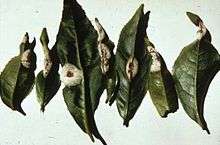Exobasidium vexans
| Exobasidium vexans | |
|---|---|
 | |
| Scientific classification | |
| Kingdom: | Fungi |
| Phylum: | Basidiomycota |
| Class: | Exobasidiomycetes |
| Subclass: | Exobasidiomycetidae |
| Order: | Exobasidiales |
| Family: | Exobasidiaceae |
| Genus: | Exobasidium |
| Species: | E. vexans |
| Binomial name | |
| Exobasidium vexans Massee, (1898) | |
Exobasidium vexans is a plant pathogen affecting tea.
Blister blight caused by Exobasidium vexans is a devastating leaf disease in tea (Camellia sinensis) in almost all tea growing regions in Asia. This disease causes serious crop losses under inclement weather conditions besides affecting quality of made tea. Although tea cultivars show varying degrees of resistance/susceptibility to blister blight, a cultivar showing total resistance to blister blight has not yet been identified.[1]
The mature two-celled basidiospores are very easily dislodged from the sterigmata and are usually to be found on the surface of the blister. In carefully collected material we have seen the mature two-celled basidiospores attached to sterigmata. Although the basidiospore is normally one-septate, as many as three septa have been seen in germinated spores. The view is expressed that the extra septa are normally formed during germination.[2]
External links
References
- ↑ http://repository.rjt.ac.lk/jspui/bitstream/7013/791/1/Molecular.pdf
- ↑ "The basidiospores of Exobasidium vexans". Transactions of the British Mycological Society. 31: 229–233. doi:10.1016/S0007-1536(48)80004-5.
- ↑ https://www.researchgate.net/publication/263633979_Use_of_ITS_Region_for_Molecular_Differentiation_of_Exobasidium_vexans_Causing_Blister_Blight_in_Tea